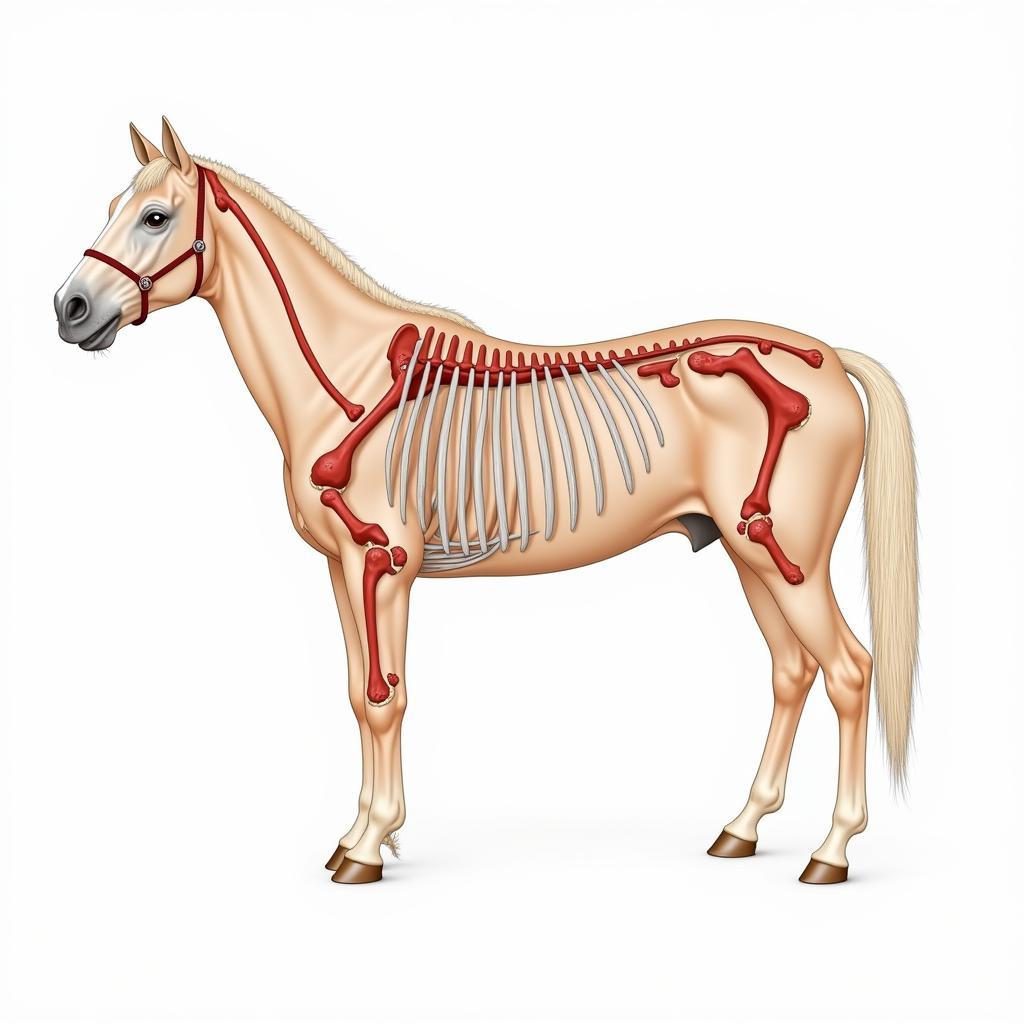The Horse Rib Cage, a complex and crucial structure, plays a vital role in protecting vital organs and supporting the horse’s body. Understanding its anatomy, function, and potential issues is essential for any horse owner or enthusiast. This article delves deep into the intricacies of the equine rib cage, offering valuable insights into its importance for overall health and performance.
 Horse Rib Cage Anatomy Diagram
Horse Rib Cage Anatomy Diagram
The rib cage is formed by a series of ribs, usually 18 pairs, which curve around from the spine to join the sternum (breastbone) via costal cartilages. This flexible framework creates a protective cavity housing vital organs like the heart and lungs. The flexibility allows for expansion during breathing and movement, crucial for athletic performance. The connection between the ribs and sternum via the costal cartilages is particularly interesting, as it allows for subtle movements that are crucial for respiration.
The Anatomy of the Equine Rib Cage
The equine rib cage is a marvel of biological engineering. Each rib, meticulously shaped and positioned, contributes to the overall function of the structure. The first few ribs, known as “true ribs,” are directly connected to the sternum. The remaining ribs, called “false ribs,” connect to the sternum indirectly through costal cartilage, or in the case of the last few “floating ribs,” not at all. This structural design allows for the expansion and contraction necessary for breathing.
Did you know that a horse’s heart is roughly the size of a basketball? This powerful organ, nestled within the rib cage, relies on the protective enclosure and the rhythmic expansion and contraction facilitated by the ribs and their cartilaginous connections. A horse saddle girth that fits correctly can help avoid unnecessary pressure on this important area.
Common Rib Cage Injuries and Conditions
While robust, the horse rib cage isn’t impervious to injury. Trauma, such as kicks or falls, can lead to fractured ribs, causing pain and restricting movement. Another common issue is “slipped” ribs, where the cartilage connecting the rib to the sternum becomes displaced, causing discomfort. Prompt veterinary attention is vital in addressing these problems.
“Regular observation of your horse’s behavior and physical condition is key to early detection of rib cage issues,” says Dr. Emily Carter, DVM, specializing in equine sports medicine. “Subtle changes in gait, breathing, or sensitivity around the chest area can be indicative of underlying problems.”
Protecting the Horse Rib Cage
Proper saddling and girthing techniques are crucial in preventing rib cage injuries. A well-fitted saddle distributes weight evenly, minimizing pressure points that could lead to discomfort or even damage. Similarly, correct girthing avoids excessive pressure and allows for comfortable breathing. Consider a vagus nerve horse girth for optimal comfort and performance.
“Investing in a well-fitted saddle and employing correct girthing techniques is essential for protecting your horse’s rib cage,” adds Dr. Carter. “These seemingly small details can make a significant difference in preventing long-term issues.”
The Role of the Rib Cage in Horse Performance
The flexibility of the horse rib cage is essential for athletic performance. During strenuous activity, the lungs expand and contract rapidly, demanding a rib cage that can accommodate these changes. A restricted or injured rib cage can hinder performance and cause respiratory distress. If you are looking for equipment to help with horse exercise, consider a horse hot walker for sale used.
The horse rib cage, a complex and dynamic structure, plays a vital role in protecting internal organs and facilitating movement and respiration. Understanding its anatomy, function, and potential problems empowers horse owners to provide the best possible care for their equine companions. Remember that proper saddle fit and girthing are crucial for preventing rib cage injuries and maintaining optimal performance. Even if you’re just looking for a swat for horses, understanding the importance of the rib cage is important for overall horse health.
FAQ
-
How many ribs does a horse typically have? Horses typically have 18 pairs of ribs.
-
What are the main functions of the horse rib cage? The rib cage protects vital organs like the heart and lungs, and it plays a crucial role in breathing and movement.
-
What are common rib cage injuries in horses? Fractured ribs and “slipped” ribs are common injuries.
-
How can I protect my horse’s rib cage? Proper saddling and girthing techniques are essential for protecting the rib cage.
-
How does the rib cage affect horse performance? The flexibility of the rib cage is crucial for athletic performance, allowing for efficient breathing during strenuous activity.
-
What should I do if I suspect my horse has a rib cage injury? Contact your veterinarian immediately for diagnosis and treatment.
-
Can a poorly fitted saddle affect the horse’s rib cage? Yes, a poorly fitted saddle can cause pressure points and potentially lead to rib cage injuries.
Common Scenarios and Questions
-
Scenario: Your horse is showing signs of discomfort when being girthed. Question: Could this be a sign of a rib cage problem?
-
Scenario: Your horse recently fell and is now showing signs of lameness. Question: Could the horse have fractured a rib?
Further Reading
You might also find these articles helpful:
- iron horse batting cage (This might seem unrelated, but demonstrates the versatility of the term “horse”)
For assistance, contact us at Phone Number: 0772127271, Email: [email protected], or visit us at QGM2+WX2, Vị Trung, Vị Thuỷ, Hậu Giang, Việt Nam. We have a 24/7 customer support team.